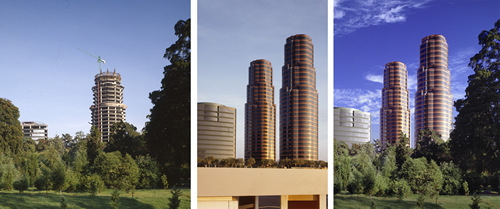
The collection found here highlights the career of Donald Barthelme (1907–1996), the first Houston architect to gain national prominence in the years after World War II. These 57 items illustrate his work through pencil sketches, photographs, and the detailed working drawings used to construct his buildings.
Barthelme first gained attention in 1936 as the lead designer for the Hall of State, the principal building of the Texas Centennial Exposition in Dallas. In 1948 he won an award from the American Institute of Architects for Houston’s St. Rose of Lima Catholic Church, applauded for its simple Scandinavian modern forms. Yet he made his reputation with the West Columbia Elementary School of 1951, which won many awards and was published internationally. Its innovative design departed from the traditional practice of placing classrooms along both sides of a long corridor. Instead, Barthelme arranged the building around two large courtyards; classrooms opened to the courts through floor-to-ceiling glass walls. This flooded the rooms with light while providing a sheltered environment for the students. At the main entrance a flamboyant scalloped canopy greeted visitors.
In addition to the St. Rose and West Columbia buildings, the collection includes Barthelme’s own residence. He built this small modernist house for his family about 1939. The original drawings are lost, but he enlarged it slightly a decade later, and the collection preserves his 1949 drawings for this remodeling.
Of particular interest, and rarely seen, are a few of his studies for the Adams Petroleum Center (1954–58), his largest and most ambitious project. The Adams Petroleum Company wanted to develop its large site as an office park. Barthelme planned to build the complex in four phases, beginning with the client’s own building. He spent hundreds of hours studying different designs for the APC tower and preparing a dramatic aerial view. The company later abandoned the scheme and constructed only a modest building without the tower.
Barthelme helped shaped the look of Houston during its postwar boom. Today only the church buildings still stand, but the West Columbia school district has preserved his entrance canopy at the original site of the elementary school.
Several of Barthelme’s children became prominent writers, and the works of his eldest son, Donald Barthelme, Jr., are preserved in the Donald Barthelme Literary Papers.
The original materials are available in UH Libraries’ Special Collections in the Donald Barthelme, Sr. Architectural Papers.
Architectural photographer Joe Aker has given a collection of images to the University of Houston Libraries Special Collections.
The Aker Architectural Photographic Records Collection comprises roughly 50,000 distinct images depicting scenes of commercial architecture over the past three decades.

Aker, owner of Aker Imaging, has worked with leading architecture and real estate firms, such as Skidmore, Owings and Merrill, Robert A.M. Stern, César Pelli, Pickard Chilton, Kohn Pedersen Fox, Philip Johnson, HOK, Kirksey and Ziegler Cooper; as well as Gerald D. Hines Interests and Trammell Crow.
In 2011, Aker began considering the future for his vast collection of photography. He contacted UH Special Collections, whose mission is to preserve, safeguard, organize, and describe primary sources in a number of collecting areas for teaching and research activities of students and scholars.
The Aker collection offers a rare view of the architectural landscape in Houston and other major cities, including a photographic record of original models of structures that were never built, as well as plans, renderings, models and final photography of the finished buildings. What makes this collection of images special are the many photographs showing the process of design from the first drawing of the first model to the final design model and the finished building.

Aker was one of the first to digitally produce structural model composites before the advent of computer-generated graphics. Working with Houston digital artist Raphaele Malandain, he would photograph a site where a building was set to be constructed, photograph the building model, and drop the model image onto the site image using analog film composition, resulting in a close representation of the future finished building.
As a whole, Aker says, the collection tells a fascinating story of Houston’s economic booms and busts. For more information on this new and growing collection, contact Vince Lee.
Thanks to Vince Lee and Esmeralda Fisher for text.